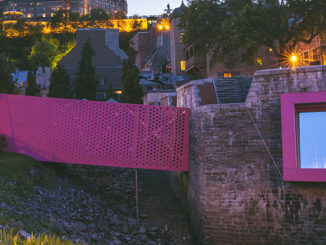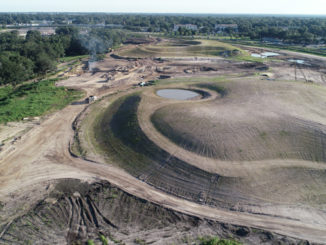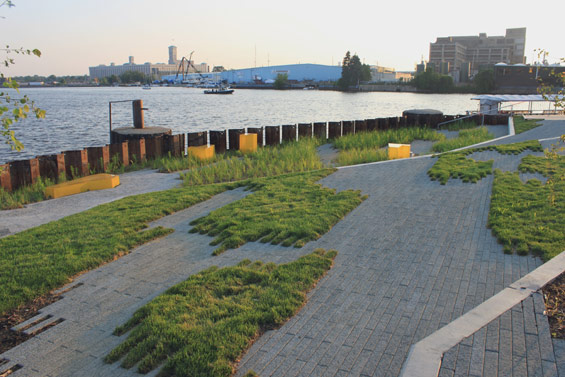
Erie Street Plaza is a small urban plaza in the Historic Third Ward district of Milwaukee, Wisconsin. The 13,000-square-foot plaza lies at the point where the Milwaukee River meets the Federal Channel as it empties into Lake Michigan. It is the final link in a series of public space activators along the Milwaukee Riverwalk, a three-mile pedestrian and bicycle corridor that connects downtown Milwaukee to the emerging and redeveloping Third Ward, Beerline Districts, and the lakefront beyond. At the beginning of the project’s design, the future of Erie Street Plaza – its users, its function, its programming, even its necessity – were undecided. The urban context was generally one of infrastructure and industry; the site lacked neighbors and potential users. The site itself was a surface parking lot, subject to harsh environmental conditions, including high winds off the lake. Who is it for? How will it be used? This uncertainty, this open-endedness, was at the core of its design.
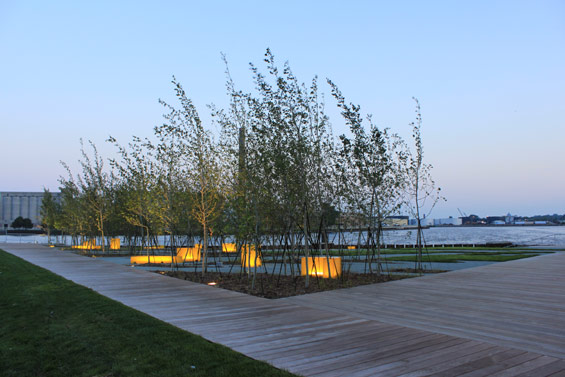
FLEXIBLE FIELD: PROGRAMMING
With no set program and no immediate stakeholders, flexibility was key. The plaza was conceived as a civic plain – simply articulated and open-ended – that would foster social and environmental activity and appropriation. The site’s variegated surface accommodates a wide range of potential uses and activities: art festivals, gatherings, concerts, movies, weddings, festivals, farmers’ markets, and winter carnivals, as well as less intense, every-day activities like boat-watching, fishing, sunbathing, and simply hanging-out.
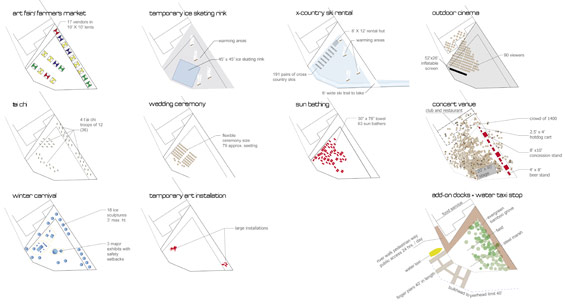
VARIGEATED SURFACE, TOPOGRAPHIC STRATEGIES, and HYBRID ECOLOGIES: DESIGN STRATEGY + ELEMENTS
The plaza is an understated assemblage of simple parts, both familiar and exotic, that pulse with the life of the Third Ward, the Riverwalk, and this unique confluence of ecological systems. The plaza is wrapped by local infrastructural and geographical frames – wooden boardwalk from the downtown Riverwalk and steel bulkhead from the Lake. Rather than following the water’s edge, the Riverwalk traces the site’s inland perimeter, reinforcing the plaza’s connection to the river, and its accommodation of ephemeral inundations.
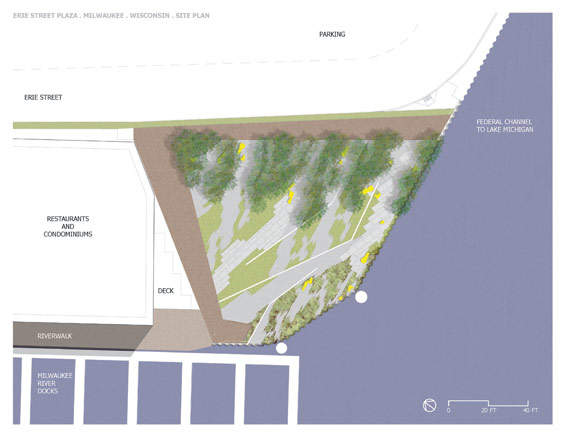
The project grows from three hybrid ecologies that step down across the site towards the water: radiant grove, flexible field, and steel marsh. The radiant grove occupies the upper end of the vegetal gradient, at the plaza’s urban edge. The poplar grove is positioned to shelter the rest of the plaza from cold winter winds yet are deliberately transparent to allow for views and safety. The grove maintains a dense straight line parallel to street edge but opens up toward the river.
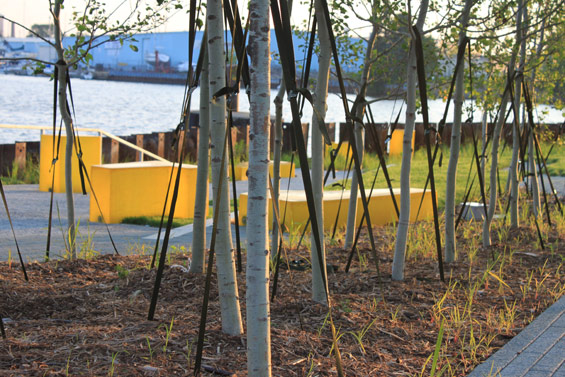
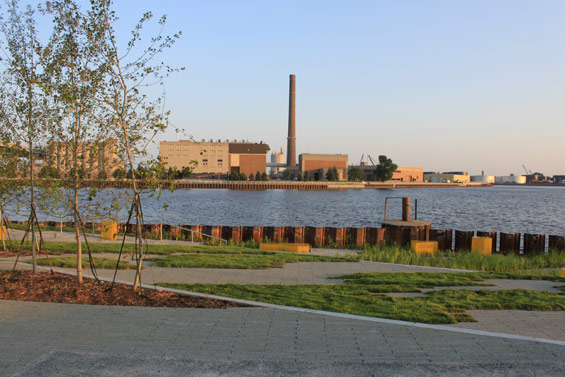
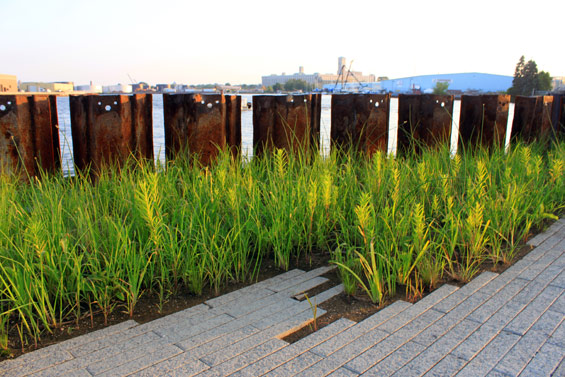
The primary element – the flexible field – is a hybridized plaza-green, with pavers and lawn surfaces that allow for both intense activity and more passive use. The plaza is articulated as an eroded field of custom pre-cast pavers distributed to maximize variability and flexibility. The plaza’s indeterminacy is accentuated by the erratic scattering of seatwalls and luminous fiberglass benches, which capture and reflect ambient light and project light from within. Their irregular placement allows for multiple and diverse social groupings or solitary retreats, in shade or full sun, protected or exposed. The luminous qualities of the fiberglass are accentuated as night falls, projecting light from within and reflecting the passing headlights of automobiles. The glowing benches have become a signature element of the project.
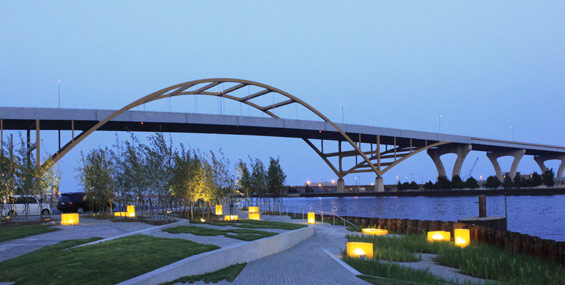
The variegated surface extends into the steel marsh, which occupies the lower end of the plaza gradient at the river’s edge. Capturing and cleaning site stormwater, the steel marsh is key to the site’s stormwater management strategy. Lowering the grade behind the bulkhead wall allowed for the collection of site stormwater in a perched position above the river, newly protected from industrial activities and barge wakes. Native marsh grasses of the type displaced by the site’s infrastructure and industry thrive in this sheltered location.
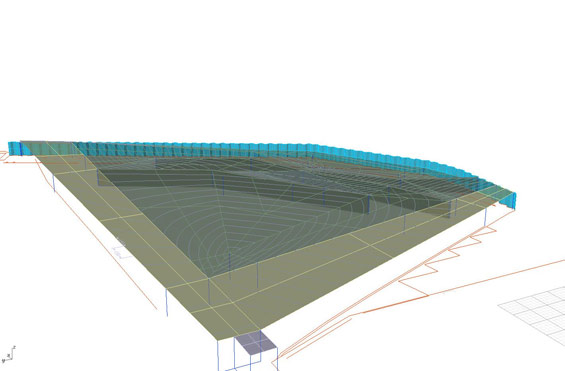
NEW NEIGHBORS, NEW LIFE: ERIE STREET PLAZA TODAY (AND TOMORROW)
Since the projects’ uncertain beginnings, adjacent new construction has brought new activity to the area and life to the plaza. Rip Tide Seafood Bar and Grill includes an outdoor dining deck, which overlooks the plaza. Condominiums have also been built nearby. This new fabric and the completion of the plaza are changing local’s perceptions of the Third Ward neighborhood. Today mid-day exercise classes and evening loungers testify to group appropriation and informal use of the plaza. The neighborhood’s future change will both impact and be accommodated within the plaza’s flexible framework. Passive, active, and occasional uses may alternately occupy the plaza’s central field; each may find its own way of uniquely inhabiting and appropriating the space. Such relatively gentle fluctuations in use could also give way to more radical or extreme evolutions as social and market factors change, or as environmental conditions shift.
Erie Street Plaza
Completion Date: 2010
Location: Milwaukee, Wisconsin, USA
Size: 13,000 sf (0.25 acres)
Designer: Stoss Landscape Urbanism
Chris Reed, principal, lead designer
Scott Bishop, project manager
Chris Muskopf, project manager
Design Team: Tim Barner, Adrian Fehrmann, Kristin Malone, Graham Palmer,
Megan Studer
Collaborators:
Vetter Denk, urban design
Light THIS!, lighting design
GRAEF Anhalt Schloemer and Associates, structural, electrical, mechanical engineering and wetland science
IMAGE & TEXT CREDIT: ©Stoss Landscape Urbanism


